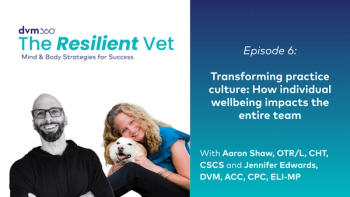
Don't let stress pollute your practice
Use these strategies to make sure tension never becomes toxic for you or your team.
"Emotional pain exists in every organization at some point, and it takes a heavy toll," says Peter Frost, Ph.D., professor of organizational behavior at the University of British Columbia. "More frequently than we'd like, valuable employees have negative experiences that leave their hopes dashed, their goals derailed, or their confidence undermined."
Frost, author of Toxic Emotions at Work: How Compassionate Managers Handle Pain and Conflict (Harvard Business School Press, 2003), says individual employees, managers, or staff members often step into emotionally poisoned work situations to help deal with the pain. These "toxic handlers," as he calls them, frequently suffer more emotional and physical damage than the people they're trying to help. "Sometimes the major toxic handler is the owner or manager, and that can mean serious damage to both the organization and the individual," Frost says.
Retired veterinarian Dan Bleicher of Abington, Pa., agrees. "In a veterinary practice where the staff must constantly deal with anxious pet owners, difficult animals, and life-and-death situations, workplace stress is a fact of life," he says. "We need to deal with that stress effectively to enjoy long-term success in practice."
Identifying workplace stress
According to The National Institute for Occupational Safety and Health, job stress is "the harmful physical and emotional responses that occur when the requirements of the job do not match the capabilities, resources, or needs of the worker. Job stress can lead to poor health and even injury."
The Canadian Mental Health Association has found similar results. According to the organization, several symptoms may indicate difficulty coping with workplace stress.
- Physical: headaches, grinding teeth, clenched jaws, chest pain, shortness of breath, pounding heart, high blood pressure, muscle aches, indigestion, constipation or diarrhea, increased perspiration, fatigue, insomnia, and frequent illness.
- Psychosocial: anxiety; irritability; sadness; defensiveness; anger; mood swings; hypersensitivity; apathy; slowed thinking or racing thoughts; and depression and feelings of helplessness, hopelessness, or of being trapped.
- Behavioral: overeating or loss of appetite; impatience; quickness to argue; procrastination; increased use of alcohol, drugs, or cigarettes; withdrawal or isolation from others; neglect of responsibility; poor job performance; poor personal hygiene; change in religious practices; and change in close family relationships.
If untended, workplace stress can lead to employee turnover, reduced efficiency, illness, or even death. Visible by-products of an over-stressed workplace can include absenteeism, illness, alcoholism, petty internal politics, bad or snap decisions, apathy, and lack of motivation or creativity.
Causes of job stress
Most scientific studies suggest that certain conditions will be stressful to a majority of people. Such things as unreasonable workloads, biased treatment by managers or supervisors, and lack of control over working conditions are certain to cause workplace stress. In this case, improved working conditions and more attention to job design are the most important ways to minimize job stress. (For more on overcoming the common stressors in veterinary practices, see "Top Pollutants in Your Practice".)
It's also true that conditions that are stressful for one person may not be for another. Personality characteristics and the worker's ability to cope are factors that determine whether conditions on the job will result in workplace stress. The solution: Find ways to help each employee cope with his or her job demands.
Effective toxic handlers
While causes of stress vary, Frost says these techniques for reducing stress apply no matter the situation:
- Slow down. You probably move quickly through your packed days. Yet the pain caused by workplace stress presents itself at a slower rate or a different cadence than the schedule you pursue to make the business successful. As a result, you could blow right by the pain, unaware it exists.
- Listen. Managers often aren't tuned into others' negative emotions, because they're too focused on solving the problem. Give your full attention to the person in pain—and to your own emotions, if you're struggling with a problem.
- Retain sensitivity. Despite the often-numbing pace of practice, be sensitive to how you and your team members feel.
- Be confident. Even if you see and feel the pain of workplace stress in others, you may feel you don't know what to do about it. Remember that simply being there for someone can help the healing process. You don't have to be an expert.
- Take action. If you find stress-generating employees, get rid of them.
- Put people first. Don't overlook the human element. Beware of toxic policies or practices that focus only on numbers, dividends, or growth but not on the people involved.
- Plant seeds. When you notice something that could cause stress in your practice down the road, start preparing people to deal with the situation now—and, if possible, do what you can to avoid the problem completely.
Of course some stress in the workplace is normal. By one definition, stress is the factor that provides us with the energy and motivation needed to stay creative and productive. You just don't want stress to rise to the level that it causes damage.
Protecting yourself
When workplace stress does cause damage, someone—usually the owner—surfaces to handle the toxicity. When you find yourself fielding emotional loose cannons, Frost suggests these tips to keep your own meltdown at bay:
- Leave it at the office. Don't take problems home with you. You can handle more toxic tension if you leave issues at work.
- Stay fit. Exercising will help you keep the toxicity out of your own system.
- Stay positive. Remember you're helping others. Feel good about what you're doing.
- Say "no" more often. You don't have to take on every case.
- Create a sanctuary. Make a space to separate yourself from office stress, such as the park or gym, and use your retreat frequently.
- Identify the job. Handling difficult emotions is meaningful work, so make it special by identifying what you're doing and titling it, if only for yourself.
- Tell loved ones how you feel. Don't let work cut you off from your partner, family, or friends.
"We live in times where there is much pain and suffering in and around organizations," says Frost. "While we can't avoid stress in the workplace, we must find better ways to manage it.
"My vision is for managers and their organizations to take up the challenge of safeguarding the health and well-being of their people," he says, "and offering compassion to those who hurt. That's a noble undertaking that is eminently practical."
Editor's Note: Dr. Frost passed away on Oct. 18, 2004, shortly after this interview.
William J. Lynott is a freelance writer in Abington, Pa. Please send questions or comments to
Newsletter
From exam room tips to practice management insights, get trusted veterinary news delivered straight to your inbox—subscribe to dvm360.




